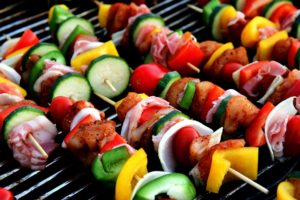Spring is here! Who isn’t ready to spend some time with friends and family in the nice weather that is coming over the next few months? And what thing always enhances gatherings with friends and family? Food! With the focus on how to be safe in social gatherings during a pandemic, it is also important to remember some food safety musts.
When it comes to COVID-19, the CDC states that the risk of contracting the virus from food that you have prepared yourself or from other sources is low. There has been no evidence of anyone contracting it from food or packaging. The virus requires a living host to survive and reproduce. Yet, the virus can still stay alive for several hours when not in a host. This is why keeping the areas around food clean is still important, not only because of COVID-19 but also because of other germs and bacteria that are transmitted by food.
The College of Education and Human Ecology at The Ohio State University recommend these easy steps to help keep yourself and guests safe:
- Remember to wash your hands up to your wrist for 20 seconds before preparing any food. Don’t touch your face, mouth or nose afterwards.
- When preparing fruits and vegetables, wash them with clean running water. Avoid using soap.
- Clean any cutting surfaces before and after use. Before switching between produce and meats, make sure to sanitize hands, surfaces and tools to avoid cross contamination.
- Keep thawing and raw meat separate and sealed from other foods.
After you have your recipes prepped, insure that your food is cooked to the correct internal temperature. Chicken and poultry requires the highest internal cooking temperature of 165°. Any ground meat should be cooked to 155°, and steaks to 145°. This includes include cooking meat on a grill. Use a clean platter when taking meat off the grill, making sure not to put cooked food on the same platter that you had your raw meat and patties on.
Once you cook food, it is important to keep it heated to above 135° to prevent bacteria from growing. To be safe, throw away food that has been at room temperature and within the “danger zone” of 135°-40° after two hours. After two hours, food should be reheated to 165°, or put back into the refrigerator. The temperature danger zone has the same two hour rule for cool, ready-to-eat foods. This could be cut fruits and vegetables, cooked and then cooled food like deviled eggs, and any other food you would normally store in your fridge. A food thermometer is the best way to measure cooking and storage temperature.
When out at a picnic site or campground, there are extra things to consider. The FDA recommends that you keep food in an ice packed cooler, and limit the number of times the lid is open. If you are at a site that does not have running water, bring a water jug and soap for hand washing.
If this information seems a bit much to remember, the Partnership for Food Safety Education website promotes the Core Four, which may help to remind you:
- Clean. Clean yourself, your cooking space, and your produce.
- Keep foods separate to prevent cross contamination.
- Cook your foods to the correct internal temperature to prevent food borne illnesses.
- Chill. Keep food stored at safe temperatures until you are ready to serve. After two hours, of food being out, toss it or put it away in the refrigerator.
We all are eager to return to a sense of normalcy. Let’s all enjoy the season and our friends and family, while keeping in mind the Core Four. No one wants to spend the warm months sick from a food borne illness that can easily be prevented!

